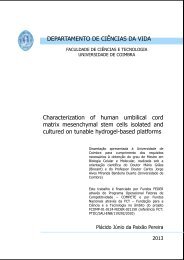role of th1 and th17 cd4+ t cell subsets in the pathogenesis of ...
role of th1 and th17 cd4+ t cell subsets in the pathogenesis of ...
role of th1 and th17 cd4+ t cell subsets in the pathogenesis of ...
Create successful ePaper yourself
Turn your PDF publications into a flip-book with our unique Google optimized e-Paper software.
44<br />
1.7 ‐ STRATEGIC THERAPIES IN MS: RENDITION FROM EAE STUDIES?<br />
Due to <strong>the</strong> complexity <strong>of</strong> CNS autoimmunity, only recently have researchers started to<br />
underst<strong>and</strong> MS pathology <strong>and</strong> EAE studies have been <strong>in</strong>valuable <strong>in</strong> <strong>the</strong> development <strong>of</strong><br />
each <strong>of</strong> <strong>the</strong> strategies described bellow <strong>and</strong> more. Positive results obta<strong>in</strong>ed <strong>in</strong> such <strong>of</strong><br />
<strong>the</strong>se studies can be fur<strong>the</strong>r confirmed with ones <strong>in</strong> MS <strong>and</strong> <strong>the</strong>n follow to <strong>the</strong> cl<strong>in</strong>ical<br />
trial phases. Naturally, many <strong>the</strong>rapies have demonstrated to be <strong>of</strong> poor efficacy <strong>and</strong><br />
o<strong>the</strong>rs with severe collateral effects. Never<strong>the</strong>less, EAE models are able to mimic <strong>the</strong><br />
relapse <strong>and</strong> remission phases <strong>of</strong> MS <strong>and</strong>, for that reason, are a precious tool to explore<br />
<strong>the</strong> pathogenic mechanisms <strong>in</strong> order to design better strategies <strong>in</strong> MS treatment.<br />
It is believed that immune <strong>cell</strong> migration, <strong>the</strong>ir adhesion to surface molecules <strong>of</strong> <strong>the</strong><br />
BBB <strong>and</strong> subsequent <strong>in</strong>filtration <strong>in</strong>to <strong>the</strong> CNS parenchyma are crucial steps <strong>in</strong> <strong>the</strong> MS<br />
<strong>and</strong> EAE <strong>pathogenesis</strong> (Engelhardt, 2008). In fact, <strong>the</strong> most famous <strong>the</strong>rapeutic strategy<br />
aim<strong>in</strong>g at <strong>the</strong> target<strong>in</strong>g <strong>of</strong> <strong>the</strong> leukocyte traffick<strong>in</strong>g across <strong>the</strong> BBB is by block<strong>in</strong>g <strong>the</strong><br />
alpha 4 subunit <strong>of</strong> <strong>the</strong> <strong>in</strong>tegr<strong>in</strong> VLA4 (very late antigen 4), a drug named Natalizumab.<br />
This strategy results <strong>in</strong> <strong>the</strong> blockade <strong>of</strong> VLA‐4, expressed by T <strong>cell</strong>s, b<strong>in</strong>d<strong>in</strong>g to <strong>the</strong><br />
vascular <strong>cell</strong>‐adhesion molecule (VCAM‐1), expressed <strong>in</strong> <strong>the</strong> BBB endo<strong>the</strong>lium, <strong>and</strong> is at<br />
present <strong>the</strong> most potent drug approved so far <strong>in</strong> <strong>the</strong> treatment <strong>of</strong> relaps<strong>in</strong>g‐remitt<strong>in</strong>g<br />
MS. Ano<strong>the</strong>r drug aim<strong>in</strong>g at <strong>the</strong> target<strong>in</strong>g <strong>of</strong> leukocyte traffick<strong>in</strong>g is <strong>the</strong> oral<br />
immunosuppressant FTY720 (F<strong>in</strong>golimod), a sph<strong>in</strong>gos<strong>in</strong>e‐1‐phosphate (S1P) analogue<br />
that sequesters lymphocytes <strong>in</strong>to <strong>the</strong> lymph nodes <strong>and</strong> <strong>the</strong>refore prevents immune <strong>cell</strong><br />
migration to <strong>the</strong> CNS. This drug is under <strong>in</strong>vestigation as a <strong>the</strong>rapy <strong>and</strong> has<br />
demonstrated a beneficial effect on disease activity <strong>in</strong> RR‐MS patients <strong>and</strong> <strong>in</strong> EAE<br />
models (Miron et al., 2008).<br />
As <strong>the</strong> humoral response also plays a <strong>role</strong> <strong>in</strong> MS, strategies aim<strong>in</strong>g at B <strong>cell</strong>s target<strong>in</strong>g<br />
have been implemented. Rituximab is a chimeric mur<strong>in</strong>e‐human antibody aga<strong>in</strong>st CD20 +<br />
pre‐B <strong>cell</strong>s <strong>and</strong> mature B <strong>cell</strong>s, <strong>the</strong>refore <strong>in</strong>terfer<strong>in</strong>g with <strong>the</strong> production <strong>of</strong> autoreactive<br />
antibodies. The mixed <strong>cell</strong> target<strong>in</strong>g strategy counts with Alentuzumab as an example. It<br />
is a humanized monoclonal antibody aga<strong>in</strong>st CD52, a <strong>cell</strong> surface molecule present <strong>in</strong> T<br />
<strong>cell</strong>s, B <strong>cell</strong>s <strong>and</strong> monocytes, <strong>and</strong> <strong>in</strong>duces immediate cytolysis <strong>of</strong> <strong>the</strong>se <strong>cell</strong>s,

















